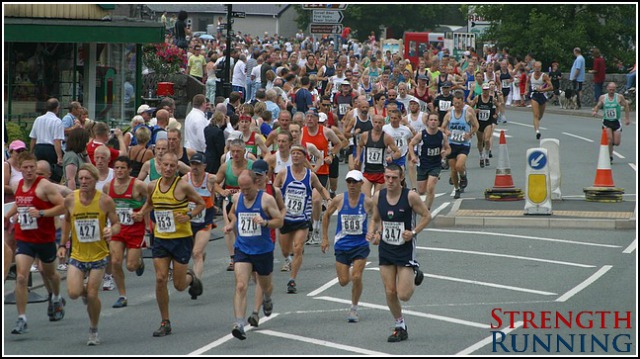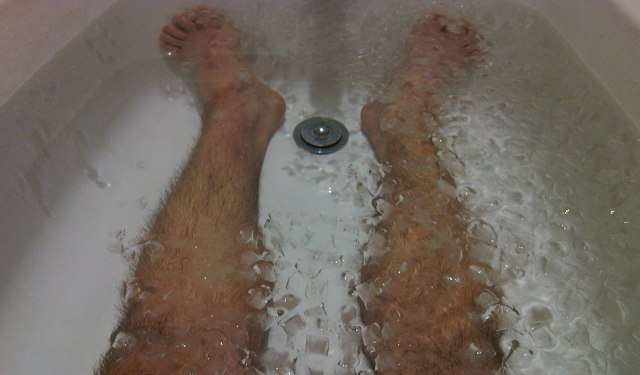The day after a marathon can seem like you’re learning to walk for the first time: short steps, no coordination, and pathetic range of motion.

With the Boston Marathon today, I want to help all those runners who are having a hard time walking. We’re going to look at some tactics to help you recover faster and minimize soreness from the race.
The sheer length of the marathon is the reason why your legs are so trashed after the race. Most marathoners never run 26.2 miles during training (even elite runners) so the distance is a shock to the body.
The soreness that you feel is the result of muscle damage – a lot of muscle damage. Marathons that are particularly hilly like Boston force your muscles to contract at the same time they’re lengthening as you descend the hills (called an eccentric muscle contraction). It’s one of the main reasons your muscles hurt so much after a hilly race.
Recovering after a marathon is a more complex process than a 10k or half-marathon. Your body experienced a lot more stress so it needs a smarter recovery plan – and that’s what we’re going to go over right now.
There’s a window of 48 hours after your marathon race that you can take advantage of to ensure you recover quickly, completely, and are ready to start running again with no injuries.
Ready? Let’s do this.
Marathon Recovery Strategy #1: Dominate Your Diet
As soon as you finish your marathon, your goal is to start replenishing your carbohydrate and fluid stores. Most marathoners don’t eat enough carbohydrates to begin with, according to a British study that followed a group of runners at the London Marathon. So you’ll need to focus on replenishing as soon as possible when you finish.
Get your gear at the bag check and eat your bagel, banana, energy bar, or whatever post-race food that you have with you. Over-eating shouldn’t be a concern at this stage – your body craves calories right now so “don’t be a blind and deaf tenant” as Dr. George Sheehan would say. Your metabolism will be in hyper-drive for the rest of the day and your muscles need to be restocked.
Many marathons offer sports drinks like Gatorade or Powerade and some even have chicken broth to help replenish your electrolyte stores. Take advantage of these resources! Almost every runner will be dehydrated at the end of 26.2 miles (especially if it’s a warm weather race like today at Boston) and it’s important to keep taking in water for the rest of the day.
I know it’s a little gross, but monitor the color of your pee for the rest of the day. It should be light yellow or clear.
Once you’ve had your post-race fuel, aim to eat a well-balanced meal within 1-2 hours. Complex carbs, protein, and vegetables – keep it simple. But also keep in mind you just ran a marathon so go a little nuts with your meal. If you want a burger and fries, go for it; but remember it’s a cheat meal not a cheat day.
Since your body does most of its muscle repair while you’re sleeping, take in an extra dose of protein right before bed. A handful of nuts, some leftover chicken, or even a protein shake will do the trick.
Strategy #2: The Art of Damage Control

Once you’re finished with the race and had some food, your focus needs to shift to damage control. There’s no avoiding the muscle damage that a marathon inflicts on your legs so you need to proactively manage the micro-tears and trauma.
Unlike a long run or hard workout where you want some soreness to promote adaptation to the training stimulus, after a marathon it’s all about recovery. Your fitness has already been tested – now you just want to walk straight again.
Follow this simple damage control protocol after your marathon to help your legs feel better:
- Immediately after the marathon keep walking for at least 10 minutes. Avoid prolonged standing.
- As soon as you can, take a 20 minute ice bath.
- Change into a pair of graduated compression socks to help promote healing blood flow for the rest of the day.
- Don’t stretch after the marathon – static stretching could make muscle damage worse.
- Don’t get a massage the day of your marathon. Just like with stretching, it could make things worse. Instead, schedule it for the next 1-2 days. Likewise, save your foam roller for the day after the race.
- If possible, take a 90 minute nap to help boost muscle repair.
- Later in the day, elevate your legs above your heart for 10-15 minutes. This can help reduce inflammation.
- You may also want to take an anti-inflammatory drug like Advil. I personally avoid Tylenol because it can damage the liver.
- If you have a Trigger Point ball, save this form of self-massage for 3-4 days after the race when your muscles have passed the acute damage phase. Those TP balls can be intense.
Strategy #3: Sleep Like a Pro
The #1 weapon you have in your recovery arsenal is sleep. Your body repairs itself primarily during the delta wave and REM cycles of sleep so you have to make it a priority. The reason why I recommend a 90 minute nap after the race is because at this length you’ll experience that super beneficial delta and REM sleep.
No wonder Ryan Hall calls them his “business meetings.”
Try to get an extra hour of sleep for a few nights after your race. Your body needs that extra time to rebuild and recover. You may want to celebrate and have a few adult beverages (I don’t blame you), but try to limit yourself to about two depending on your tolerance. Too much booze can prevent your body from entering the most restorative sleep cycles and it’s not helping you rehydrate.
If you’re going to drink then have something that can be good for you like a rich beer or glass of red wine. There are beneficial nutrients in some beers and red wine that can help you recover (but not if you have 8 of them). No shots of tequila – this isn’t Cancun. Unless you just ran a marathon in Cancun, in which case you missed the point of a Cancun vacation.
Strategy #4: Active Recovery is Better than Total Rest
You can minimize some of the delayed onset muscle damage (DOMS) you’ll feel after the race by doing a short, easy run the next day. You can do an easy 1-2 miles on a soft surface but if you’re particularly sore, zero-impact cross training like pool running or cycling might be best.
After that initial workout, you can take 2-4 days of complete rest with no exercise. Then a short dynamic stretching routine once per day can help keep you loose while increasing blood flow and preventing muscle adhesions. An easy core or body weight session can also work once you’re 5-7 days out from the race.
Obviously, if you developed any type of injury or have sharp pain, you should see your doctor to get a more structured treatment.
When you recover intelligently, you’ll be able to come back to running sooner with less pain and more motivation to run again. Who doesn’t want that?
Marathon Recovery Starts with Training
Of course, your post-marathon recovery will be far more productive if you were in proper shape to run a marathon in the first place!
The Boston Marathon is an especially tough race with the significant hills and net downhill course. Appropriate preparation for the challenging race course is the first step in ensuring your marathon recovery goes well.
Check out our popular running programs to get started.
Our runners are doing great. Here’s some feedback we’ve received:
“Your program and instruction is already making me feel so much better in my running! Where have you been all my 20 years of running? I am SO thankful to have signed up for my BIG future!!” – Jill M.
“This morning I started your program, came home, and my body felt better than it has EVER felt and now almost ½ day later, my plantar fasciitis isn’t bothering me either.”
“Tonight’s run was one of the best I’ve ever had. I completely destroyed my 8-mile tempo run. The only time I’ve ever kept a faster pace for 8 miles was the Disney Half-Marathon last year. Tonight’s run was also the most pain-free I’ve had in a long time.” – Andy G.
To say that I’m humbled by the positive responses we’re seeing is an understatement. I’m thrilled with every runner’s progress and couldn’t be happier that we have such a proactive group of marathoners who want to improve.
Don’t miss other resources to help you qualify for Boston, run a fast race, and recover properly afterard!
- Qualifying for Boston: The Thrill of Running a BQ Marathon
- The Worst Marathon Training Advice I’ve Ever Heard
- Run Your BQ is Open! Ready to Qualify for Boston?
- “What Makes Run Your BQ Different?” And 7 Other Common Questions
Until then, recover smart and good luck with your marathon!